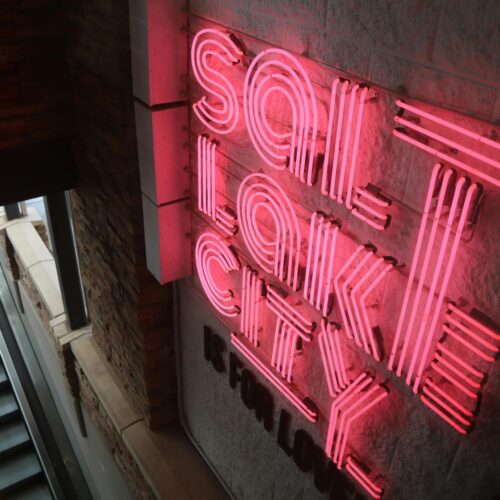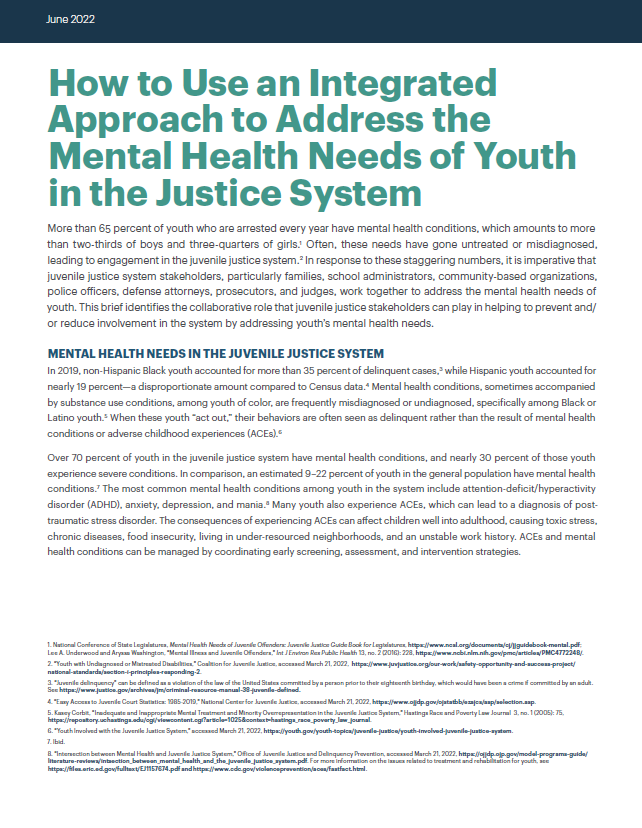How to Use an Integrated Approach to Address the Mental Health Needs of Youth in the Justice System
How to Use an Integrated Approach to Address the Mental Health Needs of Youth in the Justice System
More than 65 percent of youth who are arrested every year have mental health conditions, which amounts to more than two-thirds of boys and three-quarters of girls. Often, these needs have gone untreated or misdiagnosed, leading to engagement in the juvenile justice system. This brief identifies the collaborative role that juvenile justice stakeholders can play in helping to prevent and/or reduce involvement in the justice system by addressing youth’s mental health needs.
How to Use an Integrated Approach to Address the Mental Health Needs of Youth in the Justice System
More than 65 percent of youth who are arrested every year have mental health conditions, which amounts to more than two-thirds of boys and three-quarters of girls.¹ Often, these needs have gone untreated or misdiagnosed, leading to engagement in the juvenile justice system.² In response to these staggering numbers, it is imperative that juvenile justice system stakeholders, particularly families, school administrators, community-based organizations, police officers, defense attorneys, prosecutors, and judges, work together to address the mental health needs of youth. This brief identifies the collaborative role that juvenile justice stakeholders can play in helping to prevent and/or reduce involvement in the system by addressing youth’s mental health needs.
MENTAL HEALTH NEEDS IN THE JUVENILE JUSTICE SYSTEM
In 2019, non-Hispanic Black youth accounted for more than 35 percent of delinquent cases,3 while Hispanic youth accounted for nearly 19 percent—a disproportionate amount compared to Census data.4 Mental health conditions, sometimes accompanied by substance use conditions, among youth of color, are frequently misdiagnosed or undiagnosed, specifically among Black or Latino youth.5 When these youth “act out,” their behaviors are often seen as delinquent rather than the result of mental health conditions or adverse childhood experiences (ACEs).6
Over 70 percent of youth in the juvenile justice system have mental health conditions, and nearly 30 percent of those youth experience severe conditions. In comparison, an estimated 9–22 percent of youth in the general population have mental health conditions.7 The most common mental health conditions among youth in the system include attention-deficit/hyperactivity disorder (ADHD), anxiety, depression, and mania.8 Many youth also experience ACEs, which can lead to a diagnosis of post-traumatic stress disorder. The consequences of experiencing ACEs can affect children well into adulthood, causing toxic stress, chronic diseases, food insecurity, living in under-resourced neighborhoods, and an unstable work history. ACEs and mental health conditions can be managed by coordinating early screening, assessment, and intervention strategies.
ROLE OF JUVENILE JUSTICE STAKEHOLDERS
To ensure that the juvenile justice process is both equitable and rehabilitative for youth, it is necessary to consider whether youth have mental health conditions and how best to address them to promote positive outcomes. This requires juvenile justice stakeholders to work together. The list below identifies the role that each stakeholder can play when working with youth who are at risk of involvement in the justice system and suspected of having a mental health condition.
1. Families should have youth assessed and enter them into treatment when there is a suspected mental health condition or significant change in behavior. Families are their children’s best advocates and often the first people to recognize a significant change in behavior. If families suspect that this change could be related to a traumatic event, mental health condition, and/or substance use condition, they should inform the child’s primary care physician (PCP), as well as school administrators. Families can request a referral to a mental health clinician for further assessment and support. If the child does not have a PCP, families can contact their local department of health to obtain a referral for treatment. If there are waiting lists for mental health clinicians, families can consider working with their health insurance’s case manager to locate other clinicians.
2. Schools should hire more mental health clinicians who are able to screen, assess, and provide interventions to youth. If hiring more mental health clinicians is not feasible, schools can contract with mental health agencies to embed community-based clinicians in schools. Clinicians should work with families and community-based providers to ensure a continuity of care and remove barriers to wraparound treatment. Ideally, if youth receive the necessary services as a preventive measure, the likelihood of engagement with the juvenile justice system will decrease.9
School administrators should also refrain from referring youth who engage in non-criminal acts to school resource officers and utilizing punitive measures that include removal from school. Youth who are out of school are more likely to enter the school-to-prison pipeline.10 Instead, administrators should embrace policies that promote restorative justice practices11 and keep students in school.
3. Law enforcement agencies may want to complete any necessary mental health or substance use screeners at arrest or during intake. Problems related to mental health and co-occurring mental health and substance use conditions often play a role in delinquency when left untreated. The arresting officer or staff conducting intake can complete a screener if they suspect a mental health or substance use condition. Screeners often involve self-report and do not require the administrator to have a mental health license.12 Officers may need to create or review department policies on informed consent when obtaining behavioral health information from minors. Examples of screeners that can be used include Substance Abuse Subtle Screening Instrument-Adolescent Version Three (SASSI-A3), Pediatric Symptom Checklist (PSC-17), Alcohol Screening and Brief Intervention for Youth, and the Child and Adolescent Trauma Screen (CATS).
4. Prosecutors can work with families, the community, defense attorneys, and schools to obtain all pertinent information about the youth before reaching a disposition on a case. Prosecutors can obtain educational records, relevant health records, any prior/current treatment, prior juvenile records, and any screening results for mental health conditions or substance use conditions completed during intake/arrest. It’s critical to obtain a full picture of the youth to understand the cause of their behavior.13 For example, if a child steals from a grocery store, it may be that they have poor impulse control because of having untreated symptoms of ADHD. Understanding the underlying reason for behavior will help determine whether an unmet need should be treated through programming rather than pretrial detention or incarceration.
To support this effort, prosecutors can hire mental health and substance use clinicians. Prosecutor offices could then refer14 youth for any necessary diagnostic assessments and discuss with the clinician how diagnoses may impact youth decision-making. Prosecutors may also consult with clinicians about rehabilitative treatment options, rather than seek incarceration.
5. Defense attorneys who receive training on how to identify signs of mental health and substance use conditions are better prepared to advocate for youth and involve community-based support. Often, defense attorneys are the first people to discover a mental health need through initial conversations with a client. Several trainings15 and technical assistance16 materials have been designed to help the defense bar recognize signs of a mental health condition. Defense attorneys can work with their embedded clinicians to develop a legal strategy that utilizes their client’s diagnosis to avoid detention and obtain treatment. Legal strategies could include pretrial release and diversion options.
6. Judges may consider diversion alternatives. As previously mentioned, youth who are incarcerated have an increased rate of recidivism. Research has shown that the juvenile and criminal justice systems are largely ill-equipped to treat youth who have mental health conditions and/or substance use conditions.17 Judges can consider alternatives that provide access to treatment, such as mental health courts, drug courts, or other options like the Missouri Approach, Community Coaching, or the Balanced and Restorative Justice Model (BARJ). If these programs or services do not exist in a jurisdiction, judges could consider advocating to start them, whether through legislation, partnership with community-based programs, or by applying for state or federal grant opportunities.18
Working within the juvenile justice system can be complex. An integrated approach that requires collaboration among stakeholders has the potential to increase the likelihood of positive outcomes for youth who are at risk of becoming involved in the juvenile justice system. Collaboration can also increase engagement across the system, reduce duplicative efforts, and decrease involvement in the criminal justice system in adulthood.
DIG DEEPER
The Council of State Governments Justice Center offers free in-depth subject matter expertise and can connect people who work in the criminal justice system and mental health/substance use partners to programs and agencies that have innovative ways to work with, divert, and connect youth with mental health and/or substance use conditions to appropriate services. Visit the Center for Justice and Mental Health Partnerships to learn more.
ADDITIONAL RESOURCES
The National Juvenile Justice Network created Respect Youth Stories: A Toolkit for Advocates to Ethically Engage in Youth Justice Storytelling to help readers engage youth in credible messaging and tell firsthand accounts of their experiences.
The Office of Juvenile Justice and Delinquency Prevention (OJJDP) created a Model Programs Guide to help users obtain information on evidence-based juvenile justice and youth prevention, intervention, and reentry programs.
The Substance Abuse and Mental Health Services Administration (SAMHSA) has various resources that address mental health conditions and criminal justice issues.
ENDNOTES
1. National Conference of State Legislatures, Mental Health Needs of Juvenile Offenders: Juvenile Justice Guide Book for Legislatures, https://www.ncsl.org/documents/cj/jjguidebook-mental.pdf; Lee A. Underwood and Aryssa Washington, “Mental Illness and Juvenile Offenders,” Int J Environ Res Public Health 13, no. 2 (2016): 228, https://www.ncbi.nlm.nih.gov/pmc/articles/PMC4772248/.
2. “Youth with Undiagnosed or Mistreated Disabilities,” Coalition for Juvenile Justice, accessed March 21, 2022, https://www.juvjustice.org/our-work/safety-opportunity-and-success-project/national-standards/section-i-principles-responding-2.
3. “Juvenile delinquency” can be defined as a violation of the law of the United States committed by a person prior to their eighteenth birthday, which would have been a crime if committed by an adult. See https://www.justice.gov/archives/jm/criminal-resource-manual-38-juvenile-defined.
4. “Easy Access to Juvenile Court Statistics: 1985-2019,” National Center for Juvenile Justice, accessed March 21, 2022, https://www.ojjdp.gov/ojstatbb/ezajcs/asp/selection.asp.
5. Kasey Corbit, “Inadequate and Inappropriate Mental Treatment and Minority Overrepresentation in the Juvenile Justice System,” Hastings Race and Poverty Law Journal 3, no. 1 (2005): 75, https://repository.uchastings.edu/cgi/viewcontent.cgi?article=1025&context=hastings_race_poverty_law_journal.
6. “Youth Involved with the Juvenile Justice System,” accessed March 21, 2022, https://youth.gov/youth-topics/juvenile-justice/youth-involved-juvenile-justice-system.
7. Ibid.
8. “Intersection between Mental Health and Juvenile Justice System,” Office of Juvenile Justice and Delinquency Prevention, accessed March 21, 2022, https://ojjdp.ojp.gov/model-programs-guide/literature-reviews/intsection_between_mental_health_and_the_juvenile_justice_system.pdf. For more information on the issues related to treatment and rehabilitation for youth, see https://files.eric.ed.gov/fulltext/EJ1157674.pdf and https://www.cdc.gov/violenceprevention/aces/fastfact.html.
9. E. Michael Foster, Amir Qaseem, & Tim Connor, “Can Better Mental Health Services Reduce the Risk of Juvenile justice System Involvement”, American Journal of Public Health 94, no.5 (2004): 859, https://www.ncbi.nlm.nih.gov/pmc/articles/PMC1448349/.
10. “School-to-prison pipeline” can be defined as a collection of disciplinary policies and actions that funnel children from school toward a one-way path to the juvenile justice system and eventually to prison. See https://www.naacpldf.org/wp-content/uploads/Dismantling_the_School_to_Prison_Pipeline__Criminal-Justice__.pdf
11. For more information about restorative justice in schools can be found here.
12. Examples of screeners can be found here.
13. More information about the linkage between behavior and the cause of behavior can be found here.
14. Recommendations for treatment can be made to youth as a voluntary or involuntary (via a court order) measure.
15. Examples of mental health trainings for attorneys include those facilitated by the Global Institute of Forensic Research and Community Legal Aid. Attorneys can also access mental health training through the National Alliance on Mental Illness.
16. A checklist to help defense attorneys determine whether a client may have a mental health condition can be found here. More information about how the defense bar can assist people with mental health conditions pretrial can be found here.
17. Underwood and Washington, “Mental Illness and Juvenile Offenders.”
18. Federal grant opportunities through the Department of Justice can be found here.
Project credits:
Writing and Research: Jazmone Wilkerson, CSG Justice Center
Advising: Demetrius Thomas, CSG Justice Center
Editing: Leslie Griffin, CSG Justice Center
Web Development: Catherine Allary, CSG Justice Center


This project was supported by Grant No. 2019-BX-K001 awarded by the Bureau of Justice Assistance. The Bureau of Justice Assistance is a component of the Department of Justice’s Office of Justice Programs, which also includes the Bureau of Justice Statistics, the National Institute of Justice, the Office of Juvenile Justice and Delinquency Prevention, the Office for Victims of Crime, and the SMART Office. Points of view or opinions in this document are those of the author and do not necessarily represent the official position or policies of the U.S. Department of Justice.
About the author
The sharp rise in school shootings over the past 25 years has led school officials across the U.S.…
Read MoreA three-digit crisis line, 988, launched two years ago to supplement—not necessarily replace—911. Calling 988 simplifies access to…
Read MoreIt would hardly be controversial to expect an ambulance to arrive if someone called 911 for a physical…
Read More Taking the HEAT Out of Campus Crises: A Proactive Approach to College Safety
Taking the HEAT Out of Campus Crises: A Proactive Approach to College Safety
The sharp rise in school shootings over the past 25 years has…
Read More From 911 to 988: Salt Lake City’s Innovative Dispatch Diversion Program Gives More Crisis Options
From 911 to 988: Salt Lake City’s Innovative Dispatch Diversion Program Gives More Crisis Options
A three-digit crisis line, 988, launched two years ago to supplement—not necessarily…
Read More Matching Care to Need: 5 Facts on How to Improve Behavioral Health Crisis Response
Matching Care to Need: 5 Facts on How to Improve Behavioral Health Crisis Response
It would hardly be controversial to expect an ambulance to arrive if…
Read More










